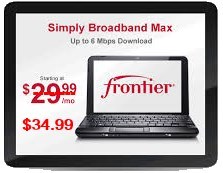 As of May 1st, Frontier Communications has raised the price of its standalone DSL service $5 a month, primarily because its competitors have also raised prices.
As of May 1st, Frontier Communications has raised the price of its standalone DSL service $5 a month, primarily because its competitors have also raised prices.
Current subscribers to Frontier’s basic 6Mbps ADSL service Simply Broadband will continue to pay $29.99 a month for now, but new customers will see a rate increase to $34.99.
“We increased the price [… because it] better reflects the value of that offering, given the robust capability of our network and comparable pricing from our competitors,” Frontier CEO Maggie Wilderotter told Wall Street analysts on a quarterly results conference call.
Frontier also announced Frontier FiOS TV price increases that “reflect increasing programming costs” also taking effect this month.
Frontier added 37,000 new broadband customers during the first quarter, a record for the company and the fifth consecutive quarter of broadband customer growth. Frontier increasingly depends on broadband to retain existing customers and develop new customer relationships in rural areas where broadband service has not been available in the past.
“As of April, 74% of our customers have access to 12Mbps, up from 60% in the fourth quarter,” said chief operating officer Dan McCarthy. “Now 61% of households we pass can get 20Mbps or greater, and 83% can get 6Mbps. At the end of the fourth quarter in 2012 only 40% of our network was capable of 20Mbps and only 50% was capable of 12Mbps.”
 Despite the speed increases, cable competitors still made their presence known. Most cable companies sell faster service than Frontier offers and on the low-end, Time Warner Cable’s 2Mbps $15 broadband package, marketed to current DSL customers, was acknowledged to have an impact by Wilderotter, but not enough to bring a significant change in competitive intensity.
Despite the speed increases, cable competitors still made their presence known. Most cable companies sell faster service than Frontier offers and on the low-end, Time Warner Cable’s 2Mbps $15 broadband package, marketed to current DSL customers, was acknowledged to have an impact by Wilderotter, but not enough to bring a significant change in competitive intensity.
Frontier continues to argue that broadband speeds are simply not that important to most customers. McCarthy claimed that less than 20% of Frontier’s broadband customers subscribe to speeds above 6Mbps.
“Quite frankly we’ve had focus groups with our customers and potential customers […] and what they say is that they don’t really know what speed they have,” McCarthy said. “They just need enough and that’s really what it’s about — providing a good quality product that’s reliable and gives them the speed that they need. It’s not necessarily a 60Mbps connection that they’re really never going to use.”
“We’ve also found [in the focus groups that we do] that a lot of customers, even those upgrading to higher speeds don’t really change their behavior,” Wilderotter added. “It’s not like they have 10Mbps more so now they’re a gamer. They just keep doing the same thing they were doing before. We still have the majority of our customers taking around 6Mbps and they have a choice to go up but they decide that that’s enough for what they’re doing and we’re happy to sell them just what they need.”
Frontier has also reduced its landline losses nationwide to 9,600 during the last quarter. It will begin running advertising this year that reminds customers landline service is often more robust than wireless or Voice over IP during power or weather-related outages. Wilderotter said emphasizing the traditional landline as a protective and security measure really resonates with Frontier’s customers.


 Subscribe
Subscribe
I don’t know anybody who gets 12Mb/s on Frontier DSL. Even the gas station that is literally across the street from their POP gets only 8MB/s.
Just another example of why DSL is too slow at any speed in rural areas.
Paul, I may be one of the “lucky” ones, but I am able to get 12Mb/s on Frontier in the thumb of Michigan.
Actually at my place close to Ithaca, NY, I get about 1.2Mb/s; I have two phone lines and two DSL lines (which Frontier won’t pair-bond for some absurd reason.) I pay $134 a month and I don’t even get TV out of the deal.
I’m part of the 17% that can only get 3Mbps(since 83% can get 6Mbps). My neighborhood is about to go 50% fiber with an outlier(non-cableco, non-telco) in the next few weeks. We will be able to go from a minimum 20Mbps up to 100Mbps, paying for each optional 5Mbps step up. Not sure that Frontier ever cared about upgrading the DSL speed here, which is the same that Verizon provided years ago.
Frontier’s mascot’s name should be “Frank the Bullcrapalo” because that is what Frontier upsells. What they can deliver on paper is not what they can deliver through the noise on their copper lines. Many rural lines would have to be replaced to deliver anything close to what they sell.